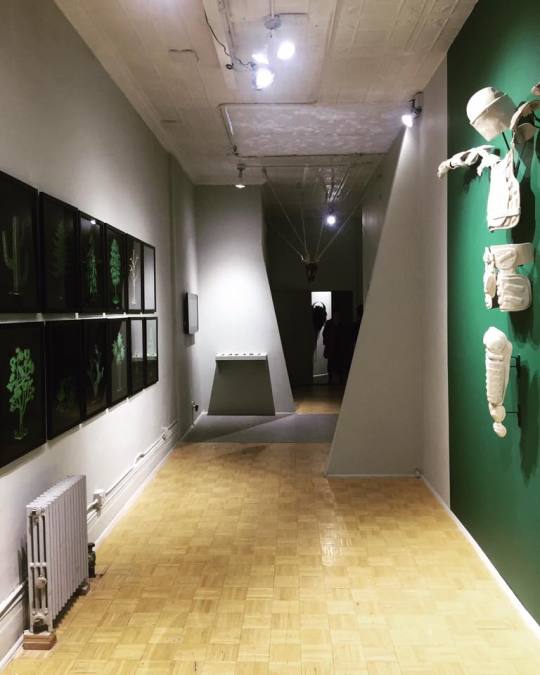Erin Joyce’s “My Country Tis of Thy People, You’re Dying”
“I very much view the work that I do as a curator as activism. With a background in contemporary Indigenous North American art, I tackle political and social issues that face Native America.”
Independent curator Erin Joyce’s new exhibition and NYFA fiscally sponsored project My Country Tis of Thy People, You’re Dying features thought-provoking works by indigenous Native American artists including Steven Yazzie, Tom Jones, and Cannupa Hanska Luger. Now on view at Radiator Gallery, the exhibition reflects upon ongoing concerns of diminishing land rights of Native Americans. Erin Joyce and founders of Radiator Gallery, Tamas Veszi and Daniela Kostova, discuss the show’s inception, inspiration, and timely place in today’s political discourse.
Title: My Country Tis of Thy People, You’re Dying
When: Now Through May 26
Where: Radiator Gallery, 10-61 Jackson Avenue, Long Island City, New York
NYFA: Erin, what inspired you to curate exhibitions that center around the work of indigenous North American artists?
Erin Joyce: I was born and grew up in the Southwest, spending many of my formative years near the Navajo (Diné) and Hopi Reservations in Northern Arizona. Being exposed to Indigenous culture and art at a young age fueled my desire to study, research, and work within that landscape. I very much view the work that I do as a curator as activism. With a background in contemporary Indigenous North American art, I tackle political and social issues that face Native America.
My Country Tis of Thy People, You’re Dying was a show I had begun working on a while ago. Native sovereignty and land rights have always been something I engaged with. In 2015, Senator John McCain, who represents my home state of Arizona, authored a National Defense Authorization Act for the Department of Defense. In this lengthy document, McCain included language that sold sacred land, Oak Flat, from the Apache San Carlos Reservation, to an Australian mining company to mine copper ore. He did this without consent from the tribe. It was at that moment that the show’s planning began, and I started spending more time researching other instances of unsanctioned land sales, most of which transpire for energy extraction purposes. My Country Tis of Thy People, You’re Dying examines those occurrences, and gives context to that fight.
NYFA: My Country Tis of Thy People, You’re Dying includes diverse media, from sculpture to film and video installation. How do these forms relate to one another in terms of creating the exhibition narrative?
EJ: When I begin working on an exhibition, the first step for me is to solidify a concept: “What am I trying to communicate?” From there, I start considering artists. Many of the artists in My Country Tis of Thy People, You’re Dying are artists I have worked with in the past. That being said, the selection of works is almost always a dialogue between the artists and myself. It is my desire to have the artists’ agency represented not only in their work, but also in the selection of those works.
I think for me, selecting work is really above the formal. I mean yes, it is nice to have pieces that are aesthetically dynamic and interesting to look at, but that is not the reason I am drawn to the work in the first place. It is about what the artist is communicating with the work – does it work within the remit of the exhibition? How will it enter into dialogue with the other work in the show? The medium is not the meaning of a work. It is the vessel, and sometimes that vessel informs the meaning.
For this show specifically, a few of the works were deliberate selections by me, such as Nicholas Galanin’s God Complex, an inspection of the dynamics of power structures, the glorification of violence, and police brutality. It is also a redressing of pop culture iconography with a religiosity echoing Western society’s worship of material over life.
Steven Yazzie’s video Mountain Song illustrates the impacts that uranium mining has had on the Navajo Reservation and the Navajo people through stunning and poignant narrative and visual imagery.
Tom Jones’ 16 photographs from his series The North American Landscape were crucial as well. They have this amazing didactic quality that allows the viewer to get a sort of 30,000 foot view of Indian reservation landscapes. It’s a series of scanned images of small plastic children’s toys, toys children often use in play that allow them to explore their relationship to nature. By using these toys and instrumentalizing their function, he inverts their meaning and refracts them through the lens of Native American, and the reservation, landscape. These were all pieces I knew I wanted in the show early on.
For the work of Cannupa Hanska Luger, a brilliant ceramicist based in Santa Fe I’ve worked with in the past, I had an idea of which pieces I wanted to include. However, I wanted Cannupa’s input in making the final selection. I love how Cannupa really embraces the materiality of natural elements in his overall concept. Using clay, fiber, and paper, he creates something from the earth that has a narrative of environmentalism and humanity, and that will eventually decompose to earth again. There is an amazingly imbricated and nuanced utilitarianism to it.

NYFA: What is your day-to-day like as an independent curator? How do you forge partnerships with exhibition spaces?
EJ: Working as an independent curator allows for a beautiful amount of freedom and flexibility in the projects I undertake. It’s so important to constantly build and maintain a network not only with artists, but with institutions, galleries, and other curators.
This show is my second Native group show at Radiator Gallery, the first being You Are On Indian Land in 2015. I connected with Radiator through a mutual friend and curator, Leo Keulbs, whom I had met two years’ prior at Dallas Aurora. I was searching for a space in New York for You are On Indian Land and asked Leo if he had any ideas of a progressive space open to working with outside curators. He immediately said Tamas Veszi and Daniela Kostova at Radiator. Radiator has been wonderful to work with – they really embraced the concepts I wanted to pursue and have given me complete curatorial freedom.
Indian Land then traveled in different iterations to two more locations, IAIA Museum of Contemporary Native Arts, and the Museum of Northern Arizona. Those relationships really transpired from calling and asking to meet with them and pitching my show ‘cold-call.’ For other projects, institutions or curators have approached me. For instance, last summer, Leo Keulbs asked me to curate a one-night installation of film to be projected onto the Manhattan Bridge for his project, Light Year. Additionally, I was invited to curate for a forthcoming exhibition at Artspace New Haven opening this winter. It is definitely a mix between contacting people and pitching shows and their approaching me.
NYFA: At what stage of the project did you apply for NYFA Fiscal Sponsorship? How did it help bring the exhibition to fruition?
EJ: The conception of this show and the planning stages transpired over the course of about a year and a half, from writing the narrative to selecting specific works to be included. Once all of the planning was solidified, we turned to NYFA for Fiscal Sponsorship. Working with smaller commercial galleries as an independent curator often means that funding for the shows is limited. Being able to work under the auspices of NYFA’s Fiscal Sponsorship program made it possible for us to apply for grants, and we were honored to receive generous support from the Shelley & Donald Rubin Foundation for the show. NYFA’s sponsorship of our project was extremely instrumental in helping this show become a reality.
NYFA: Tamas and Daniela, can you tell us a bit about Radiator Gallery’s unique place in the New York arts community? What kinds of exhibitions do you strive to present?
Radiator Gallery: Radiator Gallery opened five years ago and presents curated exhibitions showcasing both local and international artists.
The gallery’s goal is to engage the New York art scene and local audience but also to connect with the larger international arts community. We see the gallery as a curatorial interdisciplinary platform, open to both artists and curators, encouraging experimentation and collaboration. We work closely with all curators to develop their projects and provide any possible support we can in order to realize a successful project.
We run the gallery and have both had arts practices outside the United States before moving to New York, so the gallery’s interest in international exchange is natural. Tamas was born in Hungary and Daniela was born in Bulgaria. Radiator has partnered with the Austrian Cultural Forum, Art Market Budapest, The French Embassy, and the Embassy of Israel, and has also presented group shows in Vienna and Paris.
Each show is accompanied by special events such as performances, artist talks, or group panels that provide context and bring new audiences to the space.
NYFA: Why do you think it is so important to show My Country Tis of Thy People, You’re Dying in 2017?
RG: Curator Erin Joyce proposed an exhibition that is extremely relevant to the current political situation in the United States. Following the Dakota Pipeline Access protests and the last presidential election, the exhibition addresses a very important topic of land ownership and displacement of the indigenous population. All artists in the show are Native and are dedicated to issues surrounding the subject. For example, the Winter Count Collective has worked on the grounds at Standing Rock doing activist work. They also produced the amazing, poetic, and dystopian video on view, Crisis, shot with a drone flying over the desert.
This is the second show curated by Joyce for Radiator Gallery. Joyce is an Arizona-based curator, who has worked with many indigenous artists nationwide, and has done in-depth research on the history, traditions, and contemporary life of the indigenous communities in the United States. Her work is eye-opening and deserves encouragement and admiration!
Erin Joyce is an independent curator, art critic, and scholar of contemporary art. Erin’s projects include exhibitions at Radiator Gallery in New York, IAIA Museum of Contemporary Native Arts in Santa Fe, New Mexico, WAAS Gallery in Dallas, LIGHT YEAR in Brooklyn, The Contemporary in Monterey, California, the Museum of Northern Arizona, and the Coconino Center for the Arts.
Radiator Gallery provides local and international emerging and mid-career curators and artist-curators an excellent opportunity to work with and learn about the operations of a multi-disciplinary organization. Radiator regularly presents contemporary art exhibitions, performances, and video programs. To read a previous NYFA Current interview with Radiator Gallery, click here.
NYFA Fiscal Sponsorship’s next quarterly no-fee application deadline is June 30, and you can learn more about NYFA’s Fiscal Sponsorship program here. Read about other exciting projects utilizing sponsorship, in our NYFA Fiscal Sponsorship Directory.
– Interview conducted by Priscilla Son, Program Assistant, Fiscal Sponsorship & Finance
Images, from top, courtesy of Erin Joyce: Winter Count Collective, Crisis, single channel video and sound, 2016 and Cannupa Hanska Luger, Knives, ceramic, 2016; installation view





